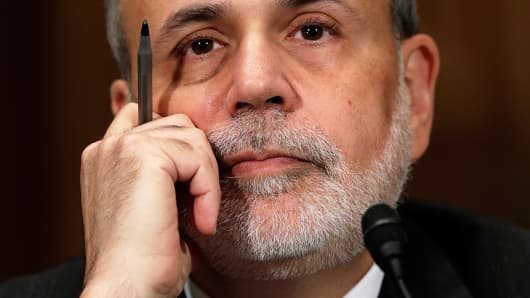The purpose of infusing capital into the US economy is to improve economic conditions, prevent deflationary risks, and initially to stabilize financial markets. With the ultimate goal of allowing the economy to grow on its own, current stimulus measures have worked to improve asset prices but underlying macro economic conditions suggest that the velocity of money that might normally increase along with aggressive stimulus like what we have seen recently does not exist.
(Read more: The Fed has enough ammo to taper: Kee)
Stimulus efforts like what we are witness to now can either influence the economy by purely infusing capital into the system or by increasing the velocity of money within the system but because the velocity of money in our current environment is so low we can reasonably conclude that the main influence of the current Fed stimulus policy is to infuse capital.
Therefore, identifying the actual capital infusions into the financial system is critical when quantifying the effect of tapering. According to my assessments, which are based on a combination of treasury action and Fed stimulus, with adjustments for foreign interest in U.S. Treasury bonds, the domestic net stimulus from our current $85 billion monthly bond-buying program is only about $16 billion per month. Review the equation below to extrapolate this detail:
Net Stimulus = FOMC stimulus - ((Treasury Issuance - refunding) X (foreign interest inverse multiplier))
Given the equation above, the current $85 billion monthly capital infusion into the financial system of the U.S. is offset by $68.91 billion per month in domestic Treasury operations. Our current factor for foreign interest is 15 percent but foreign interest in U.S. Treasury bonds has been declining steadily from recent highs near 30 percent, and although foreign interest in U.S. Treasury bonds could remain immediately weak, my assessments also suggest that foreign interest should increase going forward. I am expecting foreign interest of 20 percent or more later in calendar 2014.
(Read more: Did the Fed just say December?: Polcari)
An adjustment for foreign interest is one difference between the current influence of monetary stimulus and our evaluation of the future influence of monetary stimulus, the second being the reduced funding demands indicated by the U.S. Treasury for 2014. According to the Department of the Treasury, funding requirements decline by 23 percent in fiscal 2014 (as of September 2013) from what they were in 2013 and as a result, the U.S. Treasury expects to issue far fewer bonds in 2014 than it did in 2013. This is a critical component in a major influence to this assessment.
Given these adjustments for 2014, the equation above suggests that if the Fed continued with their $85 billion monthly capital infusion, instead of infusing $16 billion per month into the U.S. economy, it would be infusing $35.4 billion per month, given the reduced demand indicated by the Department of the Treasury. If the Fed continues on its current pace without tapering its bond buying program, it will actually increase real net stimulus by $19.4 billion per month.
This quantified observation offers three real conclusions: 1) The current $85 billion monthly program will become much more stimulative if nothing changes, 2) The FOMC could taper by about $20 billion without changing the equivalent 2013 net stimulus to the US economy, and 3) The FOMC could taper by $35.4 billion before the combined efforts of the U.S. Treasury and Federal Reserve become a drain on liquidity.
(Read more: How long will the Fed's elixir last? El-Erian)
Pundits proclaiming the need for additional Fed stimulus to drive the asset bubble even higher are not making this observation. The real net stimulus has already begun to increase measurably, and until the perception changes that will likely keep buyers in the market, especially on dips. I have provided clients with a game plan for the remainder of 2013 given this environment, but it is not one-sided at all. The environment we are in today tells us to be proactive, keep our defenses up, but we must also be aware of the facts illustrated above. The Fed has essentially just increased stimulus.
— By Thomas H. Kee, Jr.
Thomas H. Kee, Jr. is president and CEO of Stock Traders Daily and founder of The Investment Rate. Follow him on Twitter @marketcycles.


